The Mystery of the Barking Branches and the Sunken Ship, written by Judy Bradbury, illustrated by Gabriella Vagnoli; City of Light Publishing, 2021.
Meet the Cayuga Island Kids. It’s summer, and that means there’s plenty of time for adventure. Five friends set off on a hunt for a certain kind of tree—and discover a mysterious ball instead! The island they live on is home to a whole lot of history. And, it turns out, a whole lot of mystery, too. A little history, a lot of laughs, and a real sunken ship!
“Adventures await!”—Mac, The Mystery of the Barking Branches and the Sunken Ship
Why this Book? Why will it matter to kids?
In the first book in the Cayuga Island Kids chapter book series, readers meet five resourceful friends who live on a residential island. Though the story is fictional, The Mystery of the Barking Branches and the Sunken Ship is loosely based on one of the most intriguing unsolved mysteries of the Great Lakes: the sinking of the never-recovered treasure ship, the Griffon, in the 1600s. Readers encounter history, science, mystery, research skills, social-emotional themes, humor, friendship, and a really cute dog.
Levels and Layers of Learning
Grade level: Grades 1-3
Social-Emotional Learning Themes
Acceptance, commitment, compassion, concern, connection, courage, creativity, curiosity, dedication, diligence, diversity, effort, empathy, empowerment, encouragement, fortitude, friendship, generosity of spirit, gentleness, gratitude, helpfulness, honor, hope, humility, inclusion, inspiration, integrity, interpersonal relationships, justice, kindness, loyalty, patience, perseverance, persistence, perspective, resilience, resourcefulness, respect, self-assurance, self-awareness, self-reliance, tenacity, trustworthiness, understanding
Content Area Connections
English Language Arts, Social Studies, Science, Math, Geography, Art
Using This Book in the Classroom
Hit the Ground Running
Ready Resources for Educators, Homeschoolers, and Parents
The Mystery of the Barking Branches and the Sunken Ship book trailer.
Educator Guide for The Mystery of the Barking Branches and the Sunken Ship.
Write Away!
Ideas to prompt writing
Much of The Mystery of the Barking Branches and the Sunken Ship takes place in Cayuga Island Park. It’s a favorite place for the Cayuga Island Kids. Where is your favorite place to spend time with your friends? Write a description. Be specific and offer sensory details.
Yoko loves to rhyme! Throughout the story, she thinks up poems or rhymes words. Close read to find the instances in the story in which Yoko rhymes. Which is your favorite? Why? Choose a scene in the book and create a poem just as Yoko would.
Read the dedication. What questions would you ask the author or the person she dedicated the book to if you had the chance? Remember to ask questions that require more than a yes or no answer.
Find several additional writing prompts in the Educator Guide.
Poetry Break
Related poetry to recite before or following the reading of this book
Poetry breaks fit perfectly into brief moments in the day—from opening or closing the day to lining up for lunch; from zipping up backpacks to transitioning between subjects. Reading a poem typically takes less than a minute, yet it can introduce or reinforce a concept, celebrate language, exemplify rhythm, enhance vocabulary, expand understanding, increase attention span, initiate reflection, or summon a giggle. And, poetry soothes the spirit.
In The Mystery of the Barking Branches and the Sunken Ship, the Cayuga Island Kids are close friends who love adventure and working together to solve mysteries.
Poems with two voices are created to be read aloud by two people. They seem perfect for channeling the Cayuga Island Kids.
Poems for two voices can be found in the following collections:
- Joyful Noise: Poems for Two Voices by Paul Fleishman, illustrated by Eric Beddows (Newbery Medal)
- Boom! Bellow! Bleat! Animal Poems for Two or More Voices by Georgia Heard, illustrated by Aaron DeWitt
- You Read to Me, I’ll Read to You by John Ciardi, illustrated by Edward Gorey
And Then There’s This…
Enrichment activities, related books, online resources, craft projects, and ideas for further study
Read the introduction, “Cayuga Island.” Open to the map at the front of the book. Examine the details. Where on the map is the front cover illustration? Where is the bridge? Find the streets named after the explorers and the ship. Notice the labeled homes. What questions does the map raise that you hope will be answered in the story?
Follow up: Create a map of your neighborhood or the school neighborhood. Or, create a map of your public or school library.
Ask students to imagine what each of the characters in the book would choose to do in various situations. Ask students to provide evidence from the story to support their opinion.
The Griffon was a real ship. It was built on Cayuga Island in 1679 for the purpose of fur-trading. The Griffon sailed across the Great Lakes. On an early voyage, the ship sank and has never been found. It remains one of the greatest mysteries of the Great Lakes. Have students create questions and then research to find out more about this intriguing unsolved mystery.
In The Mystery of the Barking Branches and the Sunken Ship, the Cayuga Island Kids visit a college library. Visit a college library or the public library. Compare/contrast to the school library.
“There is SO MUCH packed into this amazing chapter book! Rich information is woven throughout the story. The characters learn about nature, history, science, math, geography, explorers, rhyming words, vocabulary (i.e. archives, primary sources), and more… a tome that encourages curiosity, learning, and fun! As a teacher, I love this realistic fiction story because it would be a great guided reading or shared reading text. Children in primary grades (1-3) would love this book as an independent reading selection. It would be a great book for cross-curricular learning since there is science, social studies, and math woven throughout! I can see many extension activities for teachers or parents to use with readers.”—Kirsten Burke Smith, M.S.Ed., President-Elect New York State Reading Association, 2019 NYSRA Literacy Educator of the Year
Meet the Illustrator
You can learn about me, the author of the Cayuga Island Kids series, elsewhere on this website. In this installment of the Children’s Book Corner blog, I am honored to introduce to you the illustrator of the series, Gabriella Vagnoli. I have so enjoyed getting to know Gabriella as work was underway on the illustrations for The Mystery of the Barking Branches and the Sunken Ship and Book 2 in the series, The Adventure of the Big Fish by the Small Creek. I look forward to seeing what she brings to the illustrations of the third book in the series. She “gets” the Cayuga Island Kids!

Gabriella Vagnoli ( GAHB ree ella von NYO lee) is an Italian-Brazilian illustrator living in Illinois (when she is not traveling to visit her family on two other continents). Although she grew up drawing, she found her true calling in Illustration only after exploring careers related to her other passions: Shakespeare’s plays, foreign languages, traveling, and music. She has a BA in English and Spanish Literature (Universita degli Studi di Pisa, Italy) and a BFA in Children’s Book Illustration (RMCAD).
Backstory: Q & A with Gabriella Vagnoli
Gabriella is busy with a number of children’s literature projects. She generously gave of her time to respond to a few questions about creating the illustrations for The Mystery of the Barking Branches and the Sunken Ship and her career.
Judy Bradbury: Tell us about your journey to illustrating for children.
Gabriella Vagnoli: While I always loved drawing, I came to illustration later in life. Growing up, I was raised to see the arts as something you do as a hobby rather than a career path. I was also born and raised in Italy, in a school structure that saw Art only with the capital A, as in traditional art like that of Michelangelo or Caravaggio. I always knew that Art was not what I wanted to do. It was only when I came to live in the United States that it sort of “clicked” with me. I could make a living by drawing exactly the kind of things I love drawing, and I was lucky enough to have the opportunity to go back to school and study art.
JB: How did you come to illustrate The Mystery of the Barking Branches and the Sunken Ship?
GV: Marti Gorman, the publisher of City of Light Publishing, was positively impressed by a promotional postcard I had sent to her. She contacted me and we discussed the Cayuga Island Kids project. After reading the manuscript, I was very excited for the opportunity to draw these characters for an arc of several books. In other words, I would be able to grow with them and develop them over a period of time.
JB: Of The Mystery of the Barking Branches and the Sunken Ship, Vivian Vande Velde, Edgar Award-winner author of the Twitch the Squirrel chapter books, says, “Likeable kids use their distinctive personalities and particular interests to solve mysteries. Good fun and gentle humor abound. Author Judy Bradbury subtly guides readers in how to research a subject of interest. Gabriella Vagnoli’s lively illustrations show that the children are as diverse as their interests.” Tell us how you decided on the style you used to illustrate the Cayuga Island Kids series. How did you determine the way you would illustrate each of the Cayuga Island Kids: their affects, facial expressions, identifying qualities, and even their clothing?
GV: Well, first of all the characters are very well described in the text itself. There was so much already there that I only had to translate to a drawing. For example, Mac’s outfit is there on the page, from the (fake) coonskin cap, to the powder horn, to the vest. We wanted the Cayuga Island Kids to represent America in its diversity, so I was glad to be able to do that in illustrating these characters, which I hope I achieved. Lastly, I think I always add something of myself and the people I know in the illustrations of characters I draw. In the Cayuga Island Kids, Lacey has the same hairstyle I had as a kid, and Mrs. Schieber has similar glasses and hairstyle to that of my mom when I was little. Maya’s cat Sparky is actually drawn in the likeness of my cat Ophelia, who passed away a few years ago. Julian reminds me of someone I went to school with, and so on. I guess it is the way the characters speak to me and relate to my life that inspires me to incorporate details which, I hope, in turn make them more individual and more “real.”
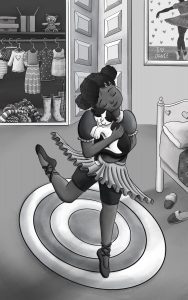
© Gabriella Vagnoli
JB: What would readers be surprised to learn about you or the illustration of the Cayuga Island Kids series?
GV: I think people will be pleasantly surprised by the level of research that went into the book. Judy really strives to combine fiction with accurate non-fiction. She sends me pages of research notes! It is something I actually try to apply in small ways in my illustrations for the Cayuga Island Kids series. In The Mystery of the Barking Branches and the Sunken Ship, I referred to the original map drawn by Louis Hennepin in 1698 to draw the map in the archives room in the library scene. I studied drawings of the Griffon as a reference for the scene in which Yoko imagines herself on board the ship. I referenced dogwood tree pictures to draw the tree. Most fun: Judy advocated for a double-page spread of a map of Cayuga Island to be placed at the front in each book in the series. I agreed! I created a double-page spread of a map of Cayuga Island as it exists in the series. I virtually drove around Cayuga Island via Google Maps to get a feel for what the island looks like since I haven’t had the pleasure to visit the place—yet! Judy and I both appreciate the nod to the map in this review:
“Any book that begins with a map of an island is my kind of story. Enliven that setting with a diverse group of characters who are consistently kind—and bursting with curiosity—and you’ve got all the elements of a series that is alive with adventure, friendship, and mystery.”—James Preller, author of the Jigsaw Jones mystery series
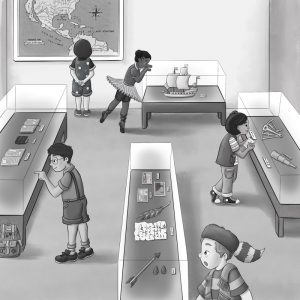
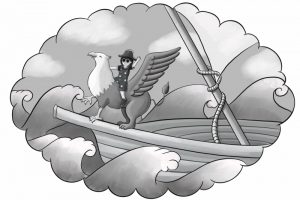
© Gabriella Vagnoli
JB: Tell about one hurdle you experienced in the creation of The Mystery of the Barking Branches and the Sunken Ship or provide a memorable (or humorous!) anecdote related to the making of this book.
GV: Something interesting I discovered during the making of The Mystery of the Barking Branches and the Sunken Ship was that there are two schools of thought when it comes to carrying a pencil behind your ear. I am of the “point forward” school of thought, and I drew it that way initially. Afterwards, I found that Judy and Marti thought it should be facing backward (for safety reasons), so I changed it. I have learned the pencil point position is one of those things, like the way you unroll toilet paper, that finds people in two schools of thought. For now, Lacey will stay in the camp of pencil point facing backwards, but I have not changed my mind and remain a supporter of the pencil point facing forward camp!
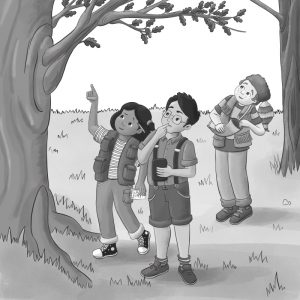
© Gabriella Vagnoli
JB: What have you learned from creating the Cayuga Island Kids series?
GV: It has been a great exercise in drawing the same characters over and over and keeping them consistent, which has improved my craft immensely. I really feel like getting to know your characters so well ends up giving you so much more freedom because you feel more comfortable drawing them in a variety of poses and expressions as time goes on.
JB: How do you see The Cayuga Island Kids series connecting to independent readers in Grades 1-3?
GV: I think The Cayuga Island Kids series is the right level of complexity for a budding reader not only in the language, but also in the story and the characterization. I think the fact that the characters are so individualized and have an immediately recognizable voice will help young readers transition to more complex reading when they are older and need to keep track of multiple characters and voices.
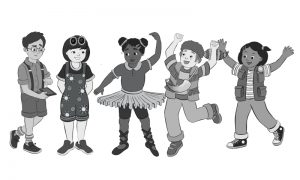
© Gabriella Vagnoli
JB: What do you hope readers will take away from The Mystery of the Barking Branches and the Sunken Ship and/or from the Cayuga Island Kids series overall?
GV: I think the series overall can show kids how to think about problems, how to utilize research to find solutions, and differentiating between truth and fiction, which is an absolutely indispensable skill in this day and age. What’s great is that the Cayuga Island Kids series does that while being lighthearted and fun. The Mystery of the Barking Branches and the Sunken Ship in particular could lead kids to be interested in looking into the history of their own town and investigating what they can discover about their own community.
JB: What is one question you wish I had asked, and what is your answer?
GV: Question: You worked on the illustrations for The Mystery of the Barking Branches and the Sunken Ship in 2020, at the beginning of the Covid pandemic. Did the situation in which you were working affect the work in any way?
Answer: I honestly think that drawing the Cayuga Island Kids helped me cope with those first few months. While it was sometimes hard to create something so joyful and lighthearted while feeling overwhelmed with worry and anxiety, it was also good to have something to focus on that would bring me out of myself the way only art can do. The Mystery of the Barking Branches and the Sunken Ship transported me to a world of joyful curiosity and exploration. I am also incredibly lucky to have two wonderful boys who adapted amazingly well to the whole pandemic. I am really proud of them.
JB: What’s up next?
GV: I have completed work on the second book in the Cayuga Island Series, The Adventure of the Big Fish in the Small Creek (coming out Fall 2021. Available now for Pre-Order! ) and I look forward to finding out what Judy has in store for the Cayuga Island Kids in the third book in the series!
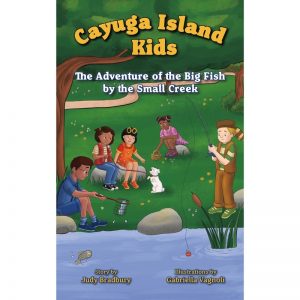
All books ship free from the publisher.
Over to You…
Join the conversation! Offer your thoughts on the featured question related to this month’s post in the comments section below. You are also welcome to post a general comment related to this month’s book.
What is a recently published chapter book you recommend for young readers?
Thanks for sharing!
News & Updates
Children can make a difference in their world. In celebration of Earth Day on April 22, Blue Dot Kids Press will PLANT A TREE—via their partnership with One Tree Planted—for each child who participates in their Earth Day activity. Separate activities geared for ages 3-8 and 8-up and further details can be found on their website.
A featured title in a recent Children’s Book Corner post, All the Way to the Top: How One Girl’s Fight for Americans with Disabilities Changed Everything by Annette Bay Pimental, illustrated by Nabi H. Ali was awarded the 2021 Schneider Family Book Award, Best Young Children’s Honor Book. An Educator Guide for the book is available.
Final Thought
“The possession of knowledge does not kill the sense of wonder and mystery. There is always more mystery.”—Anais Nin

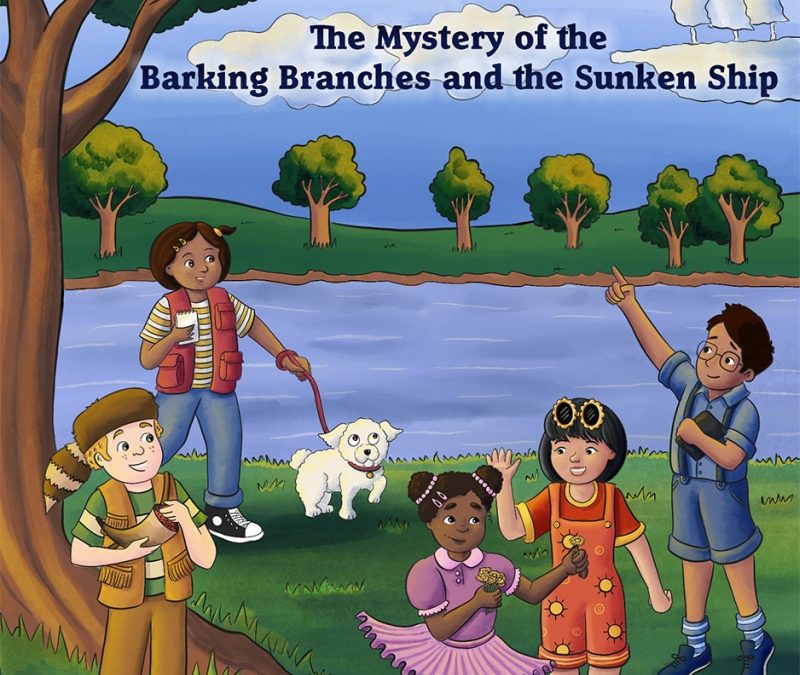
What a treat to meet the illustrator of this fun new series of books! You can tell that both author and illustrator respect each other and work well together. I was amused to learn that there is a difference of opinion about which way a pencil should be positioned when carried over an ear. This light-hearted discussion prompted me to check one of my own picture books (Bunion Burt illustrated by Jack E. Davis) where a father carries a pencil this way. Turns out I’m in Gabriella’s camp on this point, so to speak. Anyway, I admire the attention to detail and accuracy in both text and art in the Cayuga Island Kids Series. Good work by you both and great fun for young readers!
Marsha! I just went to my library of books and located your wonderful, giggle-inducing rhyming picture book Bunion Burt, and indeed your illustrator Jack E. Davis is in the Gabriella camp! Maybe it’s an artsy thing…regardless, this doesn’t mean we can’t be friends, does it?!?
Judy, I would have loved to hear your responses to the interview questions!
Truly, Vivian, that would have made for a very brief interview. I can’t even draw a stick figure, let alone five distinct characters! And a ship or a dogwood tree? You wouldn’t want me to draw those–ever. Thanks for your comment!